(Words Roger Davis – Photos: Rourke and Chiluk) – You know who hot rods a 1958 Volvo Duett PV445? The same guy who builds a street legal, nine second Geo Metro powered by a worked up turbo Buick V6. This car was built by and belongs to Roger Davis. Greg Rourke and Bob Chliluk happened upon it at the 2013 Car Craft Street Machine Nationals and they blasted away with their cameras. The car is super unique and since Davis is an engineer, it has some real trick stuff happening. David did all of the work himself and as you’d correctly guess, the car hauls ass. There’s a custom frame under it, custom suspension, a blown LS for power, and looks like nothing else in the world. The car is different and we’re going to do this feature a little differently. See, Roger’s info sheet on the car is pretty incredible and better written than we can muster so we’re going to let Roger tell you about HIS car in HIS words!
Without further adieu, here’s Roger Davis telling us all about his awesome and very unique Oldvo 1958 Volvo Duett PV445
Executive Summary
Blown LS motor – 484hp / 540tq at the rear wheels
• 4L60E automatic transmission
• Remote controlled Ride Tech Air Bag system
• Recaro seats
• Power windows
• Rare and Unique body style
• Rust free, solid body
• Fast and trouble free (8,000 miles so far) >> 11.20 in the quarter mile
The outer body shell is largely stock. The only deviation is in the front end. The front fenders have been widened by welding in a 2” strip on each fender to allow the tires to clear the bodywork at full suspension drop. The grill opening has also been lowered (widened vertically) 1-1/4”. It was primarily for looks but certainly helps with airflow. The complete “core support” or front sheetmetal inner sub structure was created from scratch to accommodate a nice big cooling package and allow the body to sit lower on the frame (channeled). The result is very stock looking and straight. I also filled in the antennae hole and the stock fugly front turn signals.
The stock hood is quite blunt at the front. I remedied that with some styling cues from the early Fords and dramatically peaked it. It has billet hood hinges that open smoothly and a late model Volkswagen latch that is mounted from below for a nice minimized and smooth look. The current air filter and intake tube prior to the throttle body will not clear however. Either the hood needs additional modification (raised scoop or similar) or a new air intake solution be created.
Prior to me getting the car, the window seals failed and water damaged the bottoms of the door frames, inner rocker panels and front floors. I replaced the front floors with NOS parts and rebuilt the inner rockers from 18 ga steel. The front doors were repaired and sealed. They are very straight and wouldn’t need replacement. The rear (barn) doors had enough rust from the inside that the damage came through the skins. I’d replace them. I have some better doors that go with the car, not rusty but more dented up. As they are now, they look all right. They would only need replacement if you wanted a shiny paint job. All the areas where rust was repaired was first sandblasted and treated with rust convertor.
Then the inside and bottom of the car were painted with epoxy sealer. The entire bottom of the car was stripped, seam sealed, primered and shot with 2 coats of coat of ceramic spray on heat and sound insulation (lizard skin). There is additional sound insulation around the air compressor pump. (Still loud but every bit helps.)
The car was wedged channelled. It was channeled ¾” in the rear and 2” at the front. This was done when the front floors and inner rockers were replaced. The factory firewall was removed and replaced by a flat sheet of 18 gauge steel that is bonded to a triangulated firewall structure of 1X1X1/8” square tubing. The front kick panel areas were rebuilt 1” wider for more foot room. (2) Full width pieces of 1” X 2” X 1/8” tubing floor reinforcements span from rocker to rocker to create a very stiff floor and serve as the seat and seat belt mounting points. Under the car, there is a 2 X ¼” steel driveshaft loop attached to these same floor braces.
The floor braces meet the inner rocker panels at reinforcement plates and extra gussets. These are there to save your butt if things ever go really bad. The seats themselves are Recaro seats from a Cobalt SS. They are manual and the drivers seat bottom adjusts up and down. The seats bottom frame was modified to narrow them up for the car and mate to custom brackets. Seating position is very comfortable. As mentioned at the very beginning though. If you are a big fellar, it’s going to be a tight fit. The car isn’t cavernous in the front. Plenty of room for the passenger, though. Most big bodies will fit over there. It is the pedal / steering wheel placement that would be bad for Andre the Giant. The tunnel was hand formed to tightly contour to the transmission and driveshaft for maximum interior space. The front floor area has ¾” plywood over it with spaces for wiring to pass.
The plywood makes a flat, perfect foundation for your carpet (or you could tile it I suppose). It is stained, sanded and sealed with 3 coats of polyurethane on all sides and bonded to the floor with silicone so it does not vibrate. Probably the best tip I’ve picked up from the pro’s is to use plywood on your floor. No better noise and heat insulation for a floor.
Moving back, the floor under the seat bottom was cut out and raised 4” (LOTS of rear headroom still. Rear leg room, well, not so much). (3) Access panels for the battery, master electrical
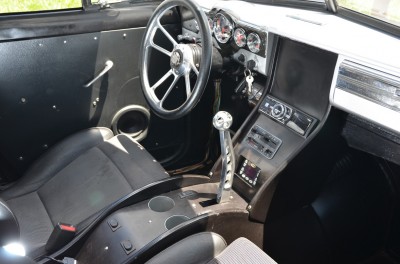 disconnect and brake reservoir are easily accessed and located under the seat bottom. The seat bottom (springs) has been narrowed to fit the mini tubbing, blasted and painted. Front seat belt anchor points were reinforced with 1/8” steel plate and welded in. The belts themselves are late model Volkswagen (black) 3 point retractables. The stock rear wheel tubs were raised up, split and widened 4”. They have been filled and smoothed so they still look stock.
disconnect and brake reservoir are easily accessed and located under the seat bottom. The seat bottom (springs) has been narrowed to fit the mini tubbing, blasted and painted. Front seat belt anchor points were reinforced with 1/8” steel plate and welded in. The belts themselves are late model Volkswagen (black) 3 point retractables. The stock rear wheel tubs were raised up, split and widened 4”. They have been filled and smoothed so they still look stock.The folding rear seat back was cut down, narrowed and had the latch mechanismrebuilt. The piano hinge was refreshed and still allows the seat to fold forward like it used to. There is a roll formed piece of 18 ga steel that fills the area behind the rear seat to the rear floor. The rear 2’ of the floor are stock except for the frenched in gas tank cover.
All interior body panels were scuffed, blasted or stripped and painted with epoxy sealer and then covered with dynamat extreme. Roof, inside doors, firewall, transmission tunnel, EVERYWHERE. The interior roof also has large panels of acoustic foam glued to the roof with contact adhesive so they won’t come off under the future headliner. The roof has (2) light sets from a late model SUV with center and aviation light pods. There are also kick panel lights up front. The interior lighting works with the doors like it should using (7) pin stainless door
Dash / Gauges
The dash is kinda stock. The gauges have been replaced with Auto Meter American Muscle gauges that sit on a carbon fiber gauge panel (Speedo/ Oil / Water / Volts / Gas). The gas gauge float arm came off the sender in the gas tank, so it needs to be reconnected to work again. The center of the dash was tunneled for the console, filled and painted with a base / clear metallic silver.There isn’t much room behind the dash for anything because of the large marge vintage air gen 2 setup. The glovebox door works, there just isn’t a glovebox, but you could build a shallow one for things. There is the factory ashtray built into the center top dash. Not installed is the matching tachometer that is included with the car. (I never decided where to put it.) There is also an Auto Meter boost gauge mounted in a fabricated and polished aluminum pod at the lower left.
Mounted on the bottom edge of the dash (discreet but still visible) is a check engine light and alternator light to warn you of problems. The OBD II port is located therealongside a manual fan control switch. The headlight switch is a Ron Francis unit with dimming control. An old switch that lights up when activated (for the line lock & gratuitous burnouts), the windshield wiper control, horn and Ron Francis ignition switch. The steering wheel is a polished, billet half wrap “Famosa” adapted to the old Volvo column. (The steering wheel horn does nothing).
The center console (upper and lower separate for service), was handmade as well. The upper contains the Vintage Air Gen 2 HVAC controls, Ride Tech Air
Bag Controller and radio. Mounted on the side is a vintage cigarette lighting / ejecting system. If you smoke, you’ll love it, if you don’t, you can sell it for $150 or so. The AC ducting behind the upper was considerable modified due to space constraints. To get the system to distribute air throughout the vehicle, new hand laid fiberglass ductwork was made for to take air and duct it to the rear seat floor area through the lower console. (Works very well.) The defrost vent was similarly modified to mate to the factory Volvo defroster vents in the dash. The HVAC works like a champ. I’ve driven in in 20º weather and while it won’t roast you out, it definitely keeps you comfortable.
All the AC components are Vintage air. It is not functional at this point. All the parts are there to make it work, hoses, wired in… It needs the front end taken back apart and the condenser installed. The powder coated brackets are all made and ready to go. Then the hoses hooked up, evacuated, charged…. The only thing not verified are the hoses to – fro the condenser.
Both the upper and lower console parts were made from ½” square tubing, 16ga steel and some 1/8” strap. Then the frames were covered in fiberglass and bodyworked smooth. All parts are removable and ready to be covered.
The lower console contains an iPhone dock for the radio connection (needs updated cable to function properly but is built in beneath the console cover so your phone sinks into the console just a bit. Lit power window switches mounted in the center as well as controls for the cup holders. The cupholders themselves are heated /cooled units and work great – they are built for a 12oz can though. Rear of console has open storage compartment. As mentioned earlier, HVAC ducting built into console and exits at rear.
All the remaining door hardware parts were cleaned, lubed and reinstalled. New parts (like springs) were used as available. New door locks were installed in the drivers and rear cargo door. All weatherstripping and window felt1 is brand new from Sweden. Power windows work great. Wing windows seal up, but the passenger side one is difficult to open, too tight a fit I guess.
The headlights have built in LED turn signals. They are lit with bi-xenon HID bulbs. The ballasts and controllers are mounted on the headlight buckets inside the fenders. They are 6000K and work very well. They don’t blind people and really light up the road nicely. The taillights are 39 Ford units with blue dots. 21 circuit wiring harness, fuse panel under drivers side of dash. Still has several un-used circuits if you want to add more stuff.
[divider]
There is about 3’ of stock-ish frame in the center. To fit the LS, I cut the stock firewall off, centered and fit the motor as low as possible (using a cut down truck orl pan) built the mounts out of round tubing and made a trans X-member to accommodate the exhaust passing through it. None of the inner stock sheetmetal remains. Structure for inner fender panels is made and in place for easy completion. The front frame was pinched and has a Heidt’s Mustang 2 front end (2” lowered spindles). I built a 1” anti-roll bar for the front. The endlinks for it are heim joints. Suspension rubbery bits are all Energy Suspension.
The rear frame was built around triangulated my own custom 4 link. It was built to have (0) anti-dive at ride height so it is very neutral. There is 1” clearance at any place from the body to the tires at any position. The main sections of the rear frame are 4 X 2 X 1/8” tubing along with some round tubing for bracing and triangulation. The rear cross member has another driveshaft loop and cutouts for the exhaust. At the rear is a very stout mount for the Class 3 trailer hitch (built into the frame design) and wiring for a 4 pin trailer plug.
The license plate is mounted to tubing that plugs into the receiver and the light plugs into the trailer wiring harness plug. At the cross member is also rear crash bars for fuel tank protection. The tank is sumped, tig welded stainless steel and holds just over 15 gallon. It is rubber mounted so you cannot hear the Walbro 255 fuel pump running or vibrating through the car. All body mounting points are rubber isolated similar to how a new car would be. Frame was blasted and primed with Eastwood rust encapsulator and sprayed with silver hammertone enamel.
The rear end is a narrowed Ford Explorer 8.8” with the factory 3.73 gears, a rebuilt posi, Moser 31 spline axles and ARP studs. The rear bags are more than capable of handling pulling a trailer (I’ve towed my 4 X 8’ trailer a few times.)
Front tires / rims are Nitto 205/50R15 on 15 X 4” Team III E-T Gasser.
Brakes
(Front) 4th gen Camaro rotors machined to fit the M2 spindles and made the caliper brackets myself. Calipers are from same Camaro and all parts for service are over the counter.
(Rear) Rebuilt explorer disc brakes with new rotors and pads.
Brake lines front and rear is bent hardline with stainless braided lines to the flexy parts. There are check valves since the master cylinder is mounted low. The booster is a hydroboost (power assist) mounted on the frame. The hydraulic lines for the brake boost are all professionally crimped and good to 5000psi. The return for the brake boost powers the M2 power rack after being regulated by the Heidt’s power steering valve. The booster itself is off of a Mitsubishi Eclipse that has a remote reservoir located under the rear seat area. (Easy to access.) The brake pedal has an adjustable pushrod to alter the pedal pad location.
Speaking of lines, all the hard and flexible lines (air, gas, battery cable, oil…) are mounted in handmade “billet” aluminum holders. Custom made, very slick, very neat. All the little bits were brushed then powder coated clear.
Engine
One thing you won’t find anywhere else is a high boost Magnacharger that experiences NO BELT SLIP. I got sick of the band-aids and made my own permanent solution. It is a hydraulically assisted unit that only applies during boost. Doesn’t use stupid spring pressure that eats belts, I’ve had the same belt on for over 6 months and it looks fine. Air gets to the blower via a polished Nick
Williams 90mm TB with the remote IAC, beautiful piece. Has ceramic coated Sanderson headers that dump into a 2-1/2” mandrel bent dual exhaust with an H pipe. Magnaflow stainless steel mufflers and exhaust dumps in front of rear tires.
The exhaust rattles at light load cruising speed. Comes and goes but the exhaust needs to be loosened up and adjusted to get rid of that damn rattle. The coils were relocated to down and back on my own brackets. New Taylor wires with Moroso Ultra 40 shielding sheath on them. Jim at Speed Inc. (Schaumburg, IL) tuned the car where it eventually made 484 / 540 at the wheels. Burns regular old 91 octane gas and doesn’t detonate, smoke, rattle – just a bit of sweet old school cam lope.
Starts and runs like a new car.
The transmission is a 4L60E that I installed a Corvette servo and B&M shift kit. It also has a 2800 stall lockup and large cooler mounted low and in front of grille opening. Braided hose and hard lines from transmission to cooler.
I’ve had great luck with Howe, so they made me a new dual pass to my dimensions. I built the fan shroud using a metal frame and laminating fiberglass around it. It’s cooled by (2) 12” Spal fans and has never overheated, even in 100º weather stuck in traffic. Everything fits pretty tight and neat.
I did all the work on this car in my garage. Every weld, every nut and bolt, every laminated piece of material, EVERYTHING. This isn’t my first car I’ve built.
My first one is a Geo Metro drag car (which eventually went 9.25 @ 157). Search YouTube for “9 sec Geo Metro” if you’re interested. It’s the Geo boss !









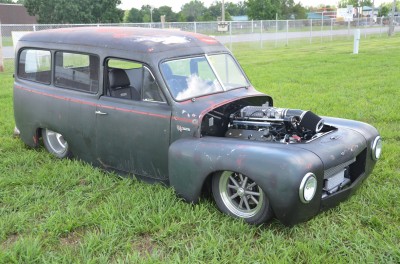
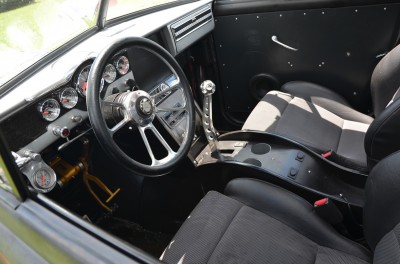
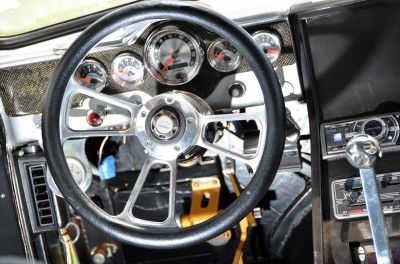
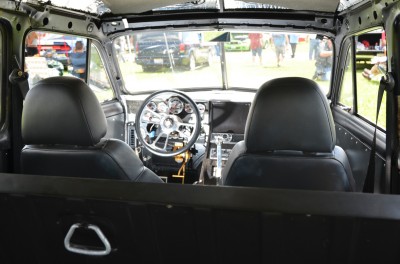
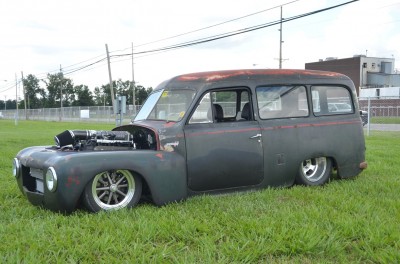
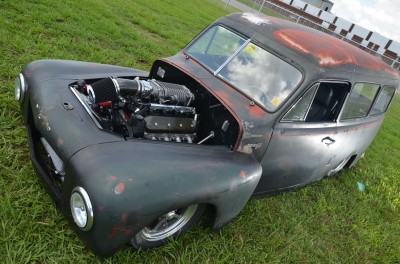
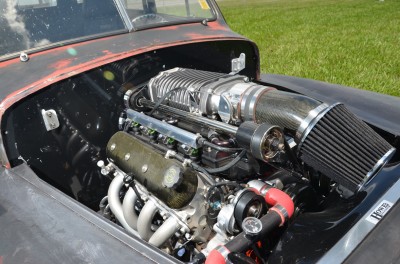
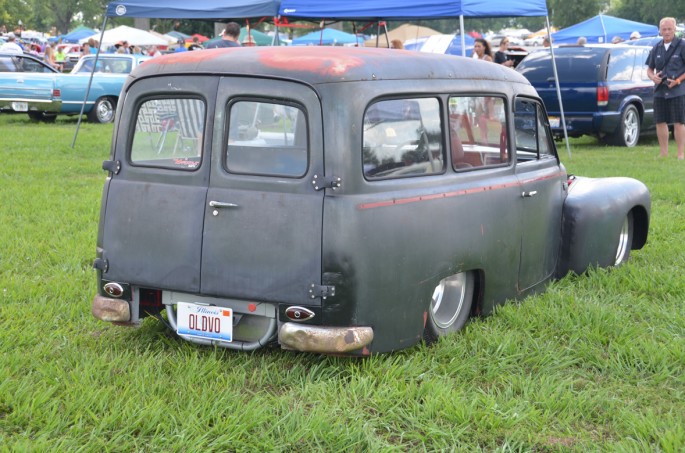
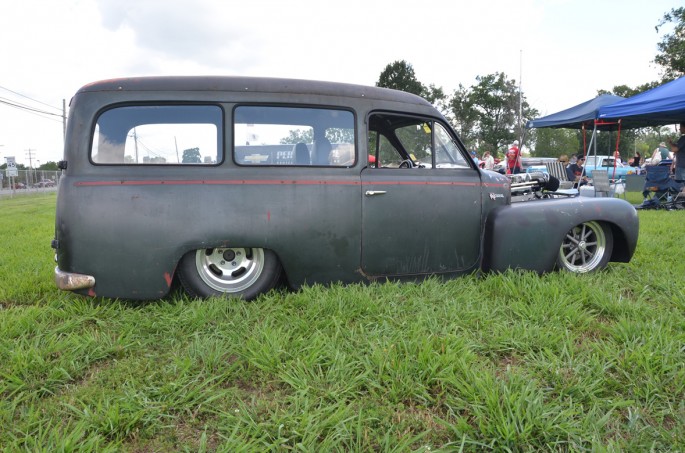

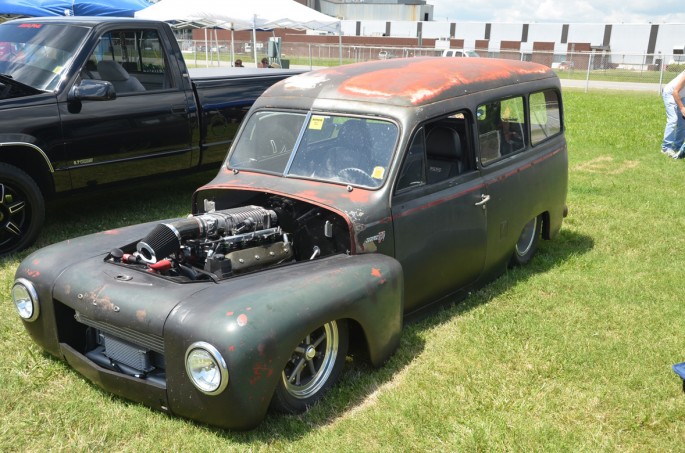
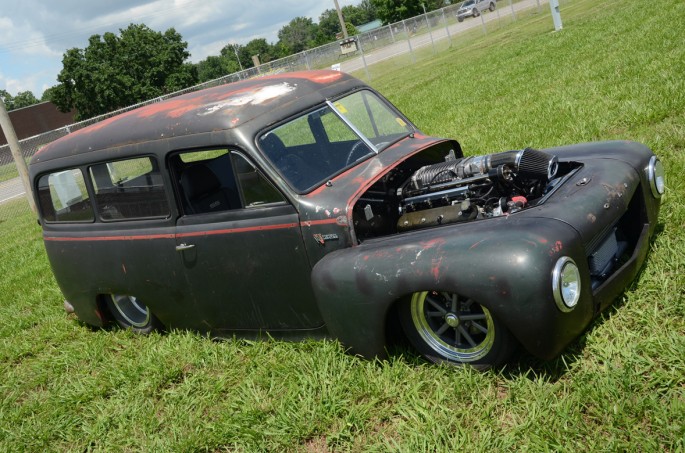


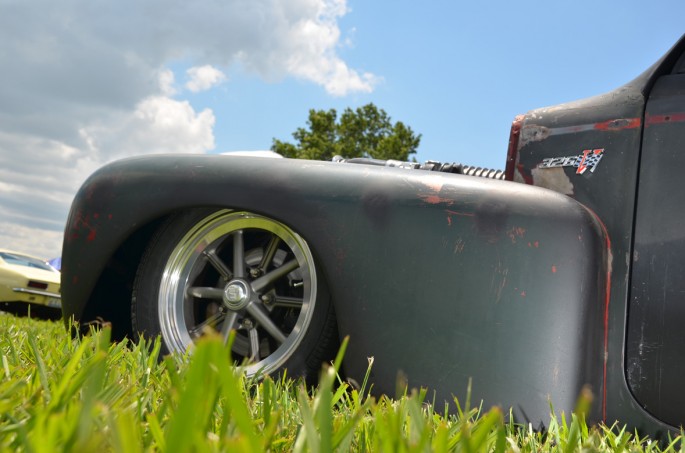







Ron David is a crazy man, CRAZY!
Also, at 6’3″ 280ish, I can confirm that passenger seat is fine, driving it takes some getting used to. It does sweet, sweet burnouts, and the blower whine from this thing is mad max-esque.
“You can see in the pictures, a lot of work has been put into the hood.” Huh???
I like it !
Outstanding job Ron. I like it too.
When I was kid I had a morning newspaper route and my boss brought the papers to my house in a Volvo Wagon like what this was originally. I love the stuff that is different so you know I fell for this wagon immediately. I too would like to see the hood……